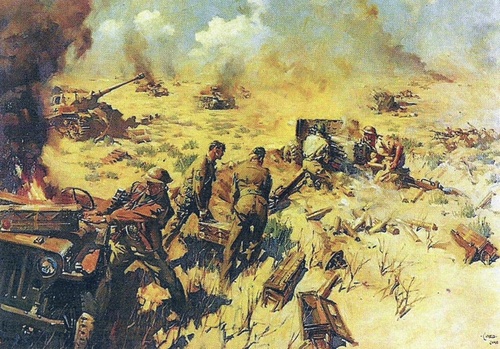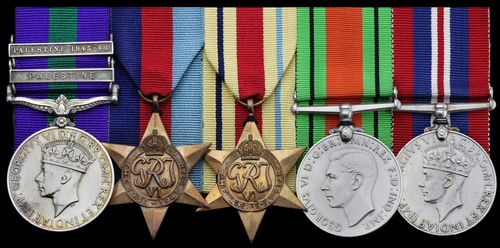Auction: 20001 - Orders, Decorations and Medals - conducted behind closed doors
Lot: 975
Five: Rifleman R. Green, Rifle Brigade
General Service 1918-62, 2 clasps, Palestine, Palestine 1945-48 (6913000 Rfmn. R. Green. Rif. Brig.); 1939-45 Star; Africa Star; Defence and War Medals 1939-45, small test mark over rank, otherwise good very fine (5)
Confirmed upon roll with the 2nd Battalion, Rifle Brigade. The 2nd Battalion served with distinction during the Second World War, their crowning glory being the legendary 'Snipe' V.C. action during El Alamein in October 1942 - described by one senior commander as ‘one of the finest actions of the War’.
Snipe
Commanded by Lieutenant-Colonel V. B. Turner, 2/Rifle Brigade had 13 6-pounders and was supported by a dozen or so sappers and six 6-pounders from 239 Anti-Tank Battery, R.A., his force numbering in total around 300 men, the whole cut-off in a scrubby depression and without artillery support, the relevant Forward Observation Officer having lost his way. Pitched against this small force were two enemy armoured groups equipped with Mk. IV or Mk. III Specials, supported by accurate 88mm. fire - in the words of the citation to Turner’s V.C., no less in fact than ‘90 enemy tanks which advanced in successive waves’. But Turner’s men remained defiant in the face of these relentless attacks, allowing the enemy armour to approach to within 200 yards before risking the expenditure of more valuable rounds from their rapidly decreasing supplies of ammunition, a range which resulted in devastating loss to the enemy.
An excellent account of 'Snipe' is to be found in Brigadier C. E. Lucas Phillips’ Alamein, including where Lieutenant-Colonel Turner stepped in as a loader - an incident famously captured on canvas by Terence Cuneo (Focus on Courage, the 59 Victoria Crosses of The Royal Green Jackets, Lieutenant-General Sir Christopher Wallace refers:
‘By now it was nearly 11 o’clock in the forenoon and the position had become extremely hot in both senses of the word. The desert was quivering with heat. The gun detachments and the platoons squatted in their pits and trenches, the sweat running in rivers down their dust-caked faces. There was a terrible stench. The flies swarmed in black clouds upon the dead bodies and excreta and tormented the wounded. The place was strewn with burning tanks and carriers, wrecked guns and vehicles, and all over drifted the smoke and dust from the bursting high explosive and from the blasts of guns. Six more carriers had been hit and set on fire. The 6-pounders of Sergeants Hine and Dolling had been knocked out and only thirteen remained in action. Sergeant Swann sent the tough little Hine to take over the gun of Corporal Cope, who had been hit. Several of the detachments were down to two or three men and officers were manning guns to replace the casualties. But the offensive spirit had firmly seized upon all ranks. The bursting shells that shook the ground and the heavy shot that smashed a gun or carrier, or that took the breath from one’s lungs with the vacuum of its close passing, could not shake the spirit. Every kill was acclaimed. At last they had got the weapon that could knock-out the Panzers ...’
Here then a small extract from Lucas Phillips’ inspiring account of 'Snipe', yet it is in his concluding paragraphs that we learn about the true significance of the action - and its cost:
‘The immediate lesson that was read to the whole Army was that, when equipped with their own 6-pounders, the infantry could themselves see off a tank attack and inflict severe losses upon the enemy. The Battalion and their Royal Artillery comrades, in resolutely holding ground that in itself was worthless, had that day struck one of the stoutest blows that helped to win the Alamein victory. They had destroyed or disabled more enemy tanks than had so far been destroyed or damaged in any single action and had shot one of the most crippling bolts in the destruction of Rommel’s counter-attack of that day.
The action gained such fame throughout the desert, becoming somewhat embroidered in the retailing, that a Committee of Investigation was appointed a month later to examine the ground, count the still remaining carcasses of the enemy tanks and sift through all the evidence critically. Their inquiry was searching. They analysed the performance of every single gun. Taking into consideration the number of wrecks that had been removed by ourselves or by the enemy, the Committee concluded that the minimum number of tanks burnt and totally destroyed was 32 - 21 German and 11 Italian - plus five self-propelled guns, and that certainly another 15, perhaps 20, tanks had been knocked out and recovered, making a grand total of 57. A few tracked and wheeled vehicles had also been destroyed. Only a very few of the tanks recovered could have been repaired before the battle ended.
This phenomenal success had not been won without its cost in flesh and blood, but, speaking relatively, the cost had not been grievously severe. Of the total force of less than 300 who had started out from the Highland lines, 72 riflemen and gunners had been killed or wounded, to which number were to be added some R.E. casualties, not ascertained. The figure would have been very much higher if they had not been well trained in the principle of “dig or die” and in the craft of concealment.’
Subject to 20% VAT on Buyer’s Premium. For more information please view Terms and Conditions for Buyers.
Sold for
£520
Starting price
£60







